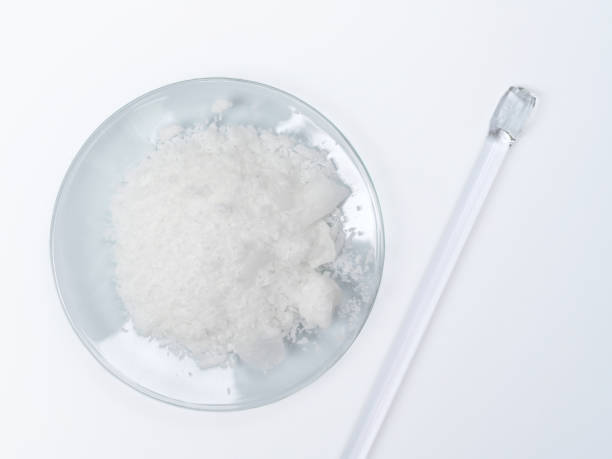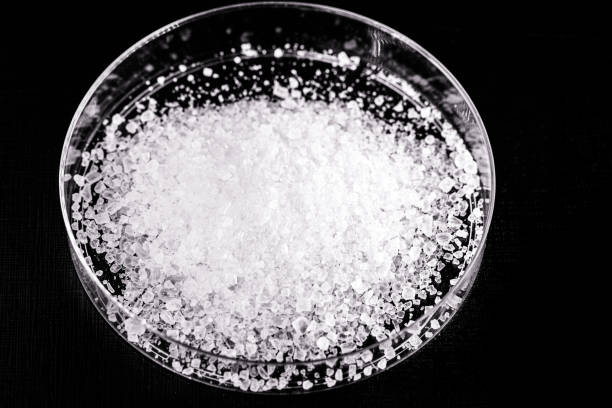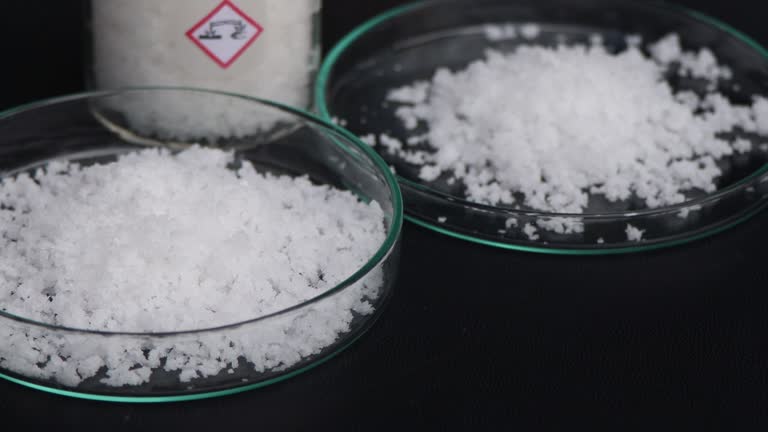Ammonium acetate is a versatile chemical compound commonly utilized in laboratories, industries, and scientific research. Represented by the chemical formula NH₄CH₃COO, it is the ammonium salt derived from acetic acid. Due to its distinctive chemical characteristics, it plays an important role in various fields such as analytical chemistry, pharmaceuticals, and biochemistry. This comprehensive guide will discuss its key properties, methods of preparation, major applications, as well as important safety and handling considerations.
Introduction to Ammonium Acetate
Ammonium acetate is a white, hygroscopic crystalline solid that dissolves readily in water. It is mildly acidic and acts as a buffering agent in chemical solutions. Due to its stability in dry conditions but decomposition in aqueous solutions, it is commonly used in laboratory analysis and industrial synthesis.
- Chemical formula: NH₄CH₃COO
- Molar mass: 77.08 g/mol
- Appearance: White crystalline solid.
- Odor: Slight acetic acid smell.
- Solubility: Highly soluble in water and ethanol.
Physical and Chemical Properties of Ammonium Acetate
Understanding its physical and chemical properties is crucial for laboratory and industrial applications.
- Melting Point: 114 °C (decomposes on heating)
- Boiling Point: Decomposes before boiling
- pH: Around 7 in neutral aqueous solutions
- Density: 1.07 g/cm³
- Hygroscopic Nature: Absorbs moisture easily from the air
- Thermal Stability: Decomposes into acetamide when heated
Ammonium acetate decomposes upon heating to produce acetic acid, ammonia, and water. This characteristic makes it useful in organic synthesis where volatile components are required.
Preparation of Ammonium Acetate

Ammonium acetate can be prepared by neutralizing acetic acid with ammonia:
CH₃COOH + NH₃ → NH₄CH₃COO
It can also be synthesized by reacting glacial acetic acid with ammonium carbonate. The process is straightforward and widely adopted in laboratories and industries due to its simplicity and efficiency.
Uses of Ammonium Acetate
1. Buffering Agent in Chemistry
It is widely used as a buffer solution in chromatography and mass spectrometry. It helps maintain a stable pH environment, especially in biological and analytical applications.
2. Reagent in Organic Synthesis
It is used as a reagent and catalyst in various organic reactions, including:
- Knoevenagel condensation
- Cyclization reactions
- Preparation of heterocyclic compounds
3. Protein Precipitation
In molecular biology, ammonium acetate is applied in DNA and RNA purification processes. It aids in removing proteins and other contaminants.
4. Food Industry Applications
Though not very common, ammonium acetate can be used as a food additive (E264), functioning as an acidity regulator and preservative in limited cases.
5. Pharmaceutical Industry
In medicine, it acts as a diuretic and expectorant, although its use is limited due to safer alternatives. It is also used in drug formulation and as a stabilizing agent.
6. Laboratory Applications
- Preparation of mobile phases in HPLC (High-Performance Liquid Chromatography).
- Used in capillary electrophoresis.
- Helps in DNA precipitation during extraction procedures.
Ammonium Acetate in Chromatography

One of the most important uses of ammonium acetate is in chromatography and mass spectrometry. It is used to prepare volatile buffers that do not interfere with electrospray ionization (ESI-MS). Its ability to stabilize pH while being easily removed during evaporation makes it ideal for analytical studies.
Role in Organic Chemistry
Ammonium acetate plays a critical role in organic synthesis due to its dual nature as a source of both ammonia and acetate ions. Some of its well-known roles include:
- Acetamide Formation: When heated, ammonium acetate decomposes to form acetamide, a valuable compound in pharmaceuticals.
- Catalyst in Reactions: Facilitates condensation and cyclization reactions.
- Precursor in Complex Compounds: Used in the synthesis of heterocyclic compounds like pyrroles, imidazoles, and quinolines.
Safety and Handling of Ammonium Acetate
While ammonium acetate is considered relatively safe, proper handling is essential.
Hazards
- May irritate the skin, eyes, and respiratory system.
- Extended exposure can cause headaches, nausea, and dizziness.
- Harmful if swallowed in large quantities.
Precautions
- Store in a cool, dry place away from moisture.
- Use personal protective equipment (PPE) such as gloves, goggles, and lab coats.
- Avoid inhalation of dust and contact with skin.
- Dispose of it in compliance with local chemical waste disposal regulations.
Storage Guidelines

Ammonium acetate should be stored in tightly closed containers to prevent it from absorbing moisture. Since it is hygroscopic, improper storage can cause clumping and degradation of its quality.
- Temperature: Room temperature, away from heat sources.
- Moisture Protection: Store in desiccators or airtight bottles.
- Shelf Life: Stable for long periods if stored properly.
Environmental Impact
Ammonium acetate is biodegradable and poses minimal environmental risk when handled correctly. However, accidental release into water bodies in large amounts can lead to increased ammonia concentration, which is harmful to aquatic life.
Conclusion
Ammonium acetate is a multifunctional compound with significant roles in chemistry, biology, pharmaceuticals, and analytical sciences. Its buffering capacity, solubility, and reactivity make it indispensable in laboratories worldwide. By understanding its properties, preparation, applications, and safety guidelines, researchers and industries can utilize ammonium acetate effectively and responsibly.
What is Ammonium Acetate?
It is a versatile chemical compound commonly utilized in laboratories, industries, and scientific research. Represented by the chemical formula NH₄CH₃COO, it is the ammonium salt derived from acetic acid. Due to its distinctive chemical characteristics, it plays an important role in various fields such as analytical chemistry, pharmaceuticals, and biochemistry. This comprehensive guide will discuss its key properties, methods of preparation, major applications, as well as important safety and handling considerations.
Introduction to Ammonium Acetate
It is a white, hygroscopic crystalline solid that dissolves readily in water. It is mildly acidic and acts as a buffering agent in chemical solutions. Due to its stability in dry conditions but decomposition in aqueous solutions, it is commonly used in laboratory analysis and industrial synthesis.
Chemical formula: NH₄CH₃COO
Molar mass: 77.08 g/mol
Appearance: White crystalline solid.
Odor: Slight acetic acid smell.
Solubility: Highly soluble in water and ethanol.
Physical and Chemical Properties of Ammonium Acetate
Understanding its physical and chemical properties is crucial for laboratory and industrial applications.
Melting Point: 114 °C (decomposes on heating)
Boiling Point: Decomposes before boiling
pH: Around 7 in neutral aqueous solutions
Density: 1.07 g/cm³
Hygroscopic Nature: Absorbs moisture easily from the air
Thermal Stability: Decomposes into acetamide when heated
It decomposes upon heating to produce acetic acid, ammonia, and water. This characteristic makes it useful in organic synthesis where volatile components are required.
Preparation of Ammonium Acetate
Ammonium acetate can be prepared by neutralizing acetic acid with ammonia:
CH₃COOH + NH₃ → NH₄CH₃COO
It can also be synthesized by reacting glacial acetic acid with ammonium carbonate. The process is straightforward and widely adopted in laboratories and industries due to its simplicity and efficiency.
Uses of Ammonium Acetate
1. Buffering Agent in Chemistry
It is widely used as a buffer solution in chromatography and mass spectrometry. It helps maintain a stable pH environment, especially in biological and analytical applications.
2. Reagent in Organic Synthesis
It is used as a reagent and catalyst in various organic reactions, including:
Knoevenagel condensation
Cyclization reactions
Preparation of heterocyclic compounds
3. Protein Precipitation
In molecular biology, ammonium acetate is applied in DNA and RNA purification processes. It aids in removing proteins and other contaminants.
4. Food Industry Applications
Though not very common, ammonium acetate can be used as a food additive (E264), functioning as an acidity regulator and preservative in limited cases.
5. Pharmaceutical Industry
In medicine, it acts as a diuretic and expectorant, although its use is limited due to safer alternatives. It is also used in drug formulation and as a stabilizing agent.
6. Laboratory Applications
Preparation of mobile phases in HPLC (High-Performance Liquid Chromatography).
Used in capillary electrophoresis.
Helps in DNA precipitation during extraction procedures.
Ammonium Acetate in Chromatography
One of the most important uses of ammonium acetate is in chromatography and mass spectrometry. It is used to prepare volatile buffers that do not interfere with electrospray ionization (ESI-MS). Its ability to stabilize pH while being easily removed during evaporation makes it ideal for analytical studies.
Role in Organic Chemistry
It plays a critical role in organic synthesis due to its dual nature as a source of both ammonia and acetate ions. Some of its well-known roles include:
Acetamide Formation: When heated, ammonium acetate decomposes to form acetamide, a valuable compound in pharmaceuticals.
Catalyst in Reactions: Facilitates condensation and cyclization reactions.
Precursor in Complex Compounds: Used in the synthesis of heterocyclic compounds like pyrroles, imidazoles, and quinolines.
Safety and Handling of Ammonium Acetate
While ammonium acetate is considered relatively safe, proper handling is essential.
Hazards
May irritate the skin, eyes, and respiratory system.
Extended exposure can cause headaches, nausea, and dizziness.
Harmful if swallowed in large quantities.
Precautions
Store in a cool, dry place away from moisture.
Use personal protective equipment (PPE) such as gloves, goggles, and lab coats.
Avoid inhalation of dust and contact with skin.
Dispose of it in compliance with local chemical waste disposal regulations.
Storage Guidelines
Ammonium acetate should be stored in tightly closed containers to prevent it from absorbing moisture. Since it is hygroscopic, improper storage can cause clumping and degradation of its quality.
Temperature: Room temperature, away from heat sources.
Moisture Protection: Store in desiccators or airtight bottles.
Shelf Life: Stable for long periods if stored properly.
Environmental Impact
It is biodegradable and poses minimal environmental risk when handled correctly. However, accidental release into water bodies in large amounts can lead to increased ammonia concentration, which is harmful to aquatic life.
Conclusion
It is a multifunctional compound with significant roles in chemistry, biology, pharmaceuticals, and analytical sciences. Its buffering capacity, solubility, and reactivity make it indispensable in laboratories worldwide. By understanding its properties, preparation, applications, and safety guidelines, researchers and industries can utilize ammonium acetate effectively and responsibly.
What are the common uses of ammonium acetate?
Is ammonium acetate soluble in water?
What is ammonium acetate used for?
It is a versatile chemical compound commonly utilized in laboratories, industries, and scientific research. Represented by the chemical formula NH₄CH₃COO, it is the ammonium salt derived from acetic acid. Due to its distinctive chemical characteristics, it plays an important role in various fields such as analytical chemistry, pharmaceuticals, and biochemistry. This comprehensive guide will discuss its key properties, methods of preparation, major applications, as well as important safety and handling considerations.
Introduction to Ammonium Acetate
It is a white, hygroscopic crystalline solid that dissolves readily in water. It is mildly acidic and acts as a buffering agent in chemical solutions. Due to its stability in dry conditions but decomposition in aqueous solutions, it is commonly used in laboratory analysis and industrial synthesis.
Chemical formula: NH₄CH₃COO
Molar mass: 77.08 g/mol
Appearance: White crystalline solid.
Odor: Slight acetic acid smell.
Solubility: Highly soluble in water and ethanol.
Physical and Chemical Properties of Ammonium Acetate
Understanding its physical and chemical properties is crucial for laboratory and industrial applications.
Melting Point: 114 °C (decomposes on heating)
Boiling Point: Decomposes before boiling
pH: Around 7 in neutral aqueous solutions
Density: 1.07 g/cm³
Hygroscopic Nature: Absorbs moisture easily from the air
Thermal Stability: Decomposes into acetamide when heated
It decomposes upon heating to produce acetic acid, ammonia, and water. This characteristic makes it useful in organic synthesis where volatile components are required.
Preparation of Ammonium Acetate
Ammonium acetate can be prepared by neutralizing acetic acid with ammonia:
CH₃COOH + NH₃ → NH₄CH₃COO
It can also be synthesized by reacting glacial acetic acid with ammonium carbonate. The process is straightforward and widely adopted in laboratories and industries due to its simplicity and efficiency.
Uses of Ammonium Acetate
1. Buffering Agent in Chemistry
It is widely used as a buffer solution in chromatography and mass spectrometry. It helps maintain a stable pH environment, especially in biological and analytical applications.
2. Reagent in Organic Synthesis
It is used as a reagent and catalyst in various organic reactions, including:
Knoevenagel condensation
Cyclization reactions
Preparation of heterocyclic compounds
3. Protein Precipitation
In molecular biology, ammonium acetate is applied in DNA and RNA purification processes. It aids in removing proteins and other contaminants.
4. Food Industry Applications
Though not very common, ammonium acetate can be used as a food additive (E264), functioning as an acidity regulator and preservative in limited cases.
5. Pharmaceutical Industry
In medicine, it acts as a diuretic and expectorant, although its use is limited due to safer alternatives. It is also used in drug formulation and as a stabilizing agent.
6. Laboratory Applications
Preparation of mobile phases in HPLC (High-Performance Liquid Chromatography).
Used in capillary electrophoresis.
Helps in DNA precipitation during extraction procedures.
Ammonium Acetate in Chromatography
One of the most important uses of ammonium acetate is in chromatography and mass spectrometry. It is used to prepare volatile buffers that do not interfere with electrospray ionization (ESI-MS). Its ability to stabilize pH while being easily removed during evaporation makes it ideal for analytical studies.
Role in Organic Chemistry
It plays a critical role in organic synthesis due to its dual nature as a source of both ammonia and acetate ions. Some of its well-known roles include:
Acetamide Formation: When heated, ammonium acetate decomposes to form acetamide, a valuable compound in pharmaceuticals.
Catalyst in Reactions: Facilitates condensation and cyclization reactions.
Precursor in Complex Compounds: Used in the synthesis of heterocyclic compounds like pyrroles, imidazoles, and quinolines.
Safety and Handling of Ammonium Acetate
While ammonium acetate is considered relatively safe, proper handling is essential.
Hazards
May irritate the skin, eyes, and respiratory system.
Extended exposure can cause headaches, nausea, and dizziness.
Harmful if swallowed in large quantities.
Precautions
Store in a cool, dry place away from moisture.
Use personal protective equipment (PPE) such as gloves, goggles, and lab coats.
Avoid inhalation of dust and contact with skin.
Dispose of it in compliance with local chemical waste disposal regulations.
Storage Guidelines
It should be stored in tightly closed containers to prevent it from absorbing moisture. Since it is hygroscopic, improper storage can cause clumping and degradation of its quality.
Temperature: Room temperature, away from heat sources.
Moisture Protection: Store in desiccators or airtight bottles.
Shelf Life: Stable for long periods if stored properly.
Environmental Impact
Ammonium acetate is biodegradable and poses minimal environmental risk when handled correctly. However, accidental release into water bodies in large amounts can lead to increased ammonia concentration, which is harmful to aquatic life.
Conclusion
It is a multifunctional compound with significant roles in chemistry, biology, pharmaceuticals, and analytical sciences. Its buffering capacity, solubility, and reactivity make it indispensable in laboratories worldwide. By understanding its properties, preparation, applications, and safety guidelines, researchers and industries can utilize ammonium acetate effectively and responsibly.
Does ammonium acetate decompose on heating?
What is the pH of the ammonium acetate solution?
Is ammonium acetate safe to handle?
What is the method of preparation of ammonium acetate?
Ammonium acetate can be prepared by neutralizing acetic acid with ammonia:
CH₃COOH + NH₃ → NH₄CH₃COO
It can also be synthesized by reacting glacial acetic acid with ammonium carbonate. The process is straightforward and widely adopted in laboratories and industries due to its simplicity and efficiency.
Uses of Ammonium Acetate
1. Buffering Agent in Chemistry
Ammonium acetate is widely used as a buffer solution in chromatography and mass spectrometry. It helps maintain a stable pH environment, especially in biological and analytical applications.
2. Reagent in Organic Synthesis
It is used as a reagent and catalyst in various organic reactions, including:
Knoevenagel condensation
Cyclization reactions
Preparation of heterocyclic compounds
3. Protein Precipitation
In molecular biology, ammonium acetate is applied in DNA and RNA purification processes. It aids in removing proteins and other contaminants.
4. Food Industry Applications
Though not very common, ammonium acetate can be used as a food additive (E264), functioning as an acidity regulator and preservative in limited cases.
5. Pharmaceutical Industry
In medicine, it acts as a diuretic and expectorant, although its use is limited due to safer alternatives. It is also used in drug formulation and as a stabilizing agent.
6. Laboratory Applications
Preparation of mobile phases in HPLC (High-Performance Liquid Chromatography).
Used in capillary electrophoresis.
Helps in DNA precipitation during extraction procedures.
